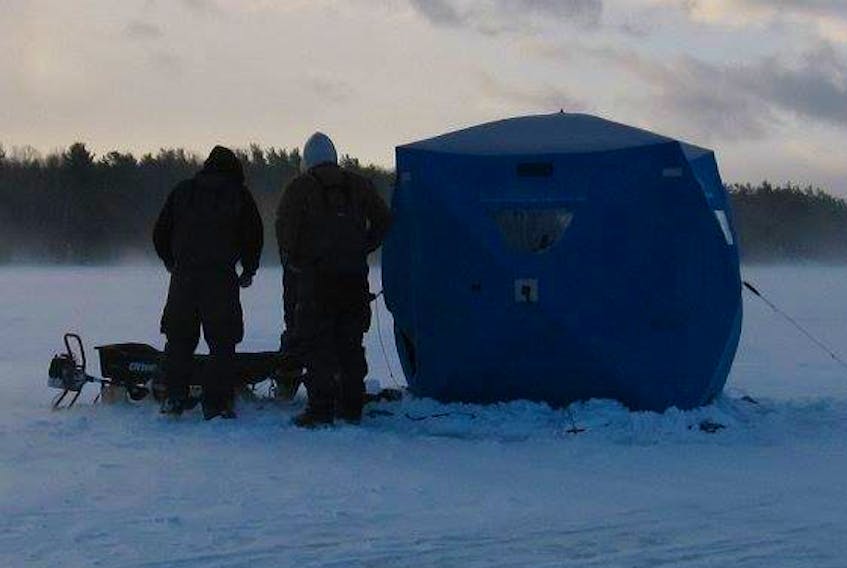Anyone who knows me knows that I have no interest in ice fishing; however, there are a lot of folks who love it, my son included. So I think that it is important to write an article about this great winter sportactivity.
Since I know very little about ice fishing I will write this column from theperspective of a beginner who is looking for help to get started. The title says “with a little help from my friends.” I asked my son and two colleagues to give me some tips on how to get started and what safety concerns there are when it comes to ice fishing. Here is what I learned: first and foremost, the ice needs to be a minimum of four inches thick. Test the ice in several areas before venturing out too far from shore.
There are basically two types of ice fishing, saltwater and freshwater. Most of the saltwater fishing is in pursuit of smelt; however, there have been reports of the odd Tommy-cod and trout being caught. Saltwater fishing is recommended for bays and coves along the shore or in the estuaries of the larger rivers. In all cases a good safety rule is to avoid moving water.
Let’s talk about gear and regulations. First of all, if you are saltwater fishing you do not need a license. If you are freshwater fishing you do need a license and your 2018 general fishing license is good until March 31, 2019. The bag limit for smelt is 60 and the bag limit for trout is two-per-day. I am going back to the Angler’s Handbook and recommend that you look up what lakes are available for your area to fish in the winter.
Let’s talk about safety. There is a lot of concern about where the ice connects to the shore. In saltwater, high tide may push the ice up against the shore and low tide may pull it away. Bob told me one day he headed home from smelt fishing and wound up three metres from shore. He also mentioned, “Do you realize how cold the water is that time of year?”
As for freshwater ice fishing , the edge will break up first from sun, rain or warm temperatures. Ice is very slippery so cleats or some type of anti-slip footwear is a must. Don’t forget sun screen also. My son, Matthew, says to check the ice continuously by using a technique called spud baring. What is spud baring you ask? Well you take a bar that you can sink into the ice ahead of you to continuously check the thickness of the ice. A wind break is also important and water-proof boots will come in handy. Remember to dress in layers so you can remove clothes if needed. Sweating in the winter while being outdoors can cause you a lot of grief when the temperature drops, so try not to sweat.
Last but not least, Mother Nature is unpredictable and ice thickness may vary drastically from one step to the next. So there is some equipment you should bring with you in case you do fall in. Ice picks which you carry on your person at all times are a must. Ice picks left in your shelter will not help a bit if you fall through the ice. A throw rope or pole can be a life-saver and always fish with a buddy.
While researching information for this article, I found several great videos on what to do and how to get out if you fall through the ice. Watch some of these helpful videos before you venture out for the first time.
I know you are thinking, “I thought this was a fishing article?” Everyone has their own favourites but here are some basic techniques and equipment that have been suggested by my friends. Of course the first thing is a hole to fish through. Most people use an auger but a bar, ice pick or axe will also all do the trick. Remember to chip away the sides of the hole as a hooked fish will go sideways when nearing the hole which means your line will be scraping on the ice. There are many rod types and lines. Buy something in your price range and remember hand-lining works as well.
All three of my advisors recommended that you fish close to bottom, using a weight or jig head to keep your bait at the bottom. Live bait works well, such as worms, shrimp and clams. For smelt fishing, the best bait to use is sand worms found along the shore where there is a muddy/sandy bottom at low tide. If you decide to use these worms you need a license from DFO to harvest them. Many folks use power baits while ice fishing. When smelt fishing you are allowed to use a line with six hooks or five lines. But take note freshwater fishermen — only one hook for you.
A few other tips for freshwater fishing is to go down to a four-pound test line so it will be harder for the fish to see it. Also, put an in-line swivel in your leader to keep the bait from continually spinning. Noisy baits may also attract fish. If you fish the lake during the regular season, start ice fishing where you caught fish in the fall. When fishing slows down and you plan to move to a new hole, make small moves.
I hope that everyone had an enjoyable holiday and all the best in the New Year from me and my family and dacaraFishin.
Carroll Randall owns and operates dacaraFishin out of Lunenburg County and is a Nova Scotia Licensed Fishing Guide. He offers guided fishing adventures and fishing schools. To book a trip or to find out more, call 902-212-1508 or email [email protected].









